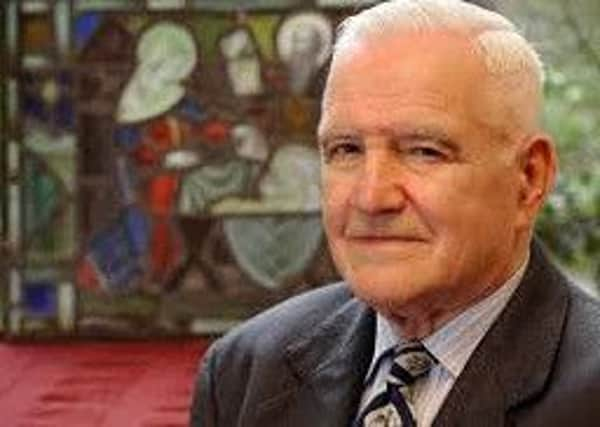Obituary: Peter Gibson OBE, stained glass craftsman


The fortunes of the Royal Scots Greys gave a gift to York of the man who would rescue one of the city’s greatest treasures, the 16 century Rose Window in its Minster, from destruction by fire.
Peter Gibson, who in 1984 led the expert team that removed, restored, and replaced the 22ft diameter, half-ton window after a blaze that made news worldwide, was the son of a Scotsman who with his regiment had been stationed in York at the end of the First World War.
Advertisement
Hide AdAdvertisement
Hide AdThat Scottish soldier, Private William Gibson, and his wife, Mary, a local girl, made their home in Precentor’s Court, close to the Minster, and their son Peter, with his older sister Ellen, grew up steeped in the colour and splendour of one of Europe’s greatest medieval buildings.
By the time of the fire, on 9 July, 1984, which was thought to have been caused by lightning, Peter Gibson had acquired 40 years’ experience of looking after the Minster’s fabric, and was superintendent of its glass specialists, York Glaziers Trust. The problem with which he was confronted on the morning after the fire was how to stick together a window that had been cracked by the heat into 40,000 pieces. For an answer, provided by the latest scientific advances, Gibson looked to his ancestral Scotland. He went to Glasgow Museums and to their then chief conservation scientist, Dr Norman Tennent, who came up with the solution: an adhesive called Ablebond 342-1.
This would be injected by pipette into the many fissures in the centuries-old glass. The glue was made in the United States. Gibson also took advice from York University’s Physics department.
On the night of the fire, Gibson was woken by an urgent telephone call asking for his help. The blaze had first been noticed at about 2.30am. Earlier there had been a storm, during which at least a dozen people had reported seeing a bolt of lightning apparently strike the Minster’s roof.
It took three hours for the flames to be brought under control. Soon after, Gibson was at the top of a fireman’s ladder, swaying 100 feet above the city’s streets to examine the still-hot glass. The Rose Window, made by Flemish craftsmen to commemorate the wedding in 1486 of England’s King Henry VII to Elizabeth of York, was high at the end of the Minster’s south transept, where the fire had been most intense and had destroyed timbers, causing the roof to collapse.
It took Gibson and his team of seven conservators two and a half weeks carefully to remove the window’s 73 panels. They had to climb up 105 steps to the narrow inspection ledge half a dozen times each day. The panels were secured with adhesive tape until they could be taken to the workshop to be cleaned, glued, and re-leaded. The Rose Window was back in place in early 1987, and the following year, on 4 November, 1988, the Queen visited for the Minster’s re-dedication service and to be shown by Gibson round the York Glaziers Trust workshops.
Gibson was appointed MBE in 1984, and OBE in 1995. His expertise in stained glass took him all over Europe and around the world; Italy in 1989 made him a Knight of the Order of Merit of the Italian Republic.
Gibson’s career started on the day he left Nunthorpe Secondary Modern School in York in 1945, when he was invited by the Dean of York to take up an apprenticeship in the Minster workshops. That dean was Eric Milner-White, DSO, First World War hero and art connoisseur, who as the Second World War loomed, had been responsible for removing many priceless stained glass church, chapel and cathedral windows for safety from bombing.
Advertisement
Hide AdAdvertisement
Hide AdAt York, as elsewhere, there was much work to be done in putting the panes back in place.
As well as studying medieval glass in France, Gibson obliged when a model was needed for the figure of Jesse, missing from a window depicting the Tree of Jesse that belonged in the Minster’s nave.
Milner-White’s ambition was to make York a centre of renown and skill in stained glass, and after his death in 1963 Gibson achieved just that. The Minster workshops were transformed in 1967 into York Glaziers’ Trust, a charitable organisation, and as its first superintendent, Gibson would cycle to visit historical buildings and identify glass needing attention.
In later years Gibson lectured in the United States, Israel, Germany, France, and the Netherlands. He also gave evening talks for inmates at Leeds prison. In 2001 he sat on the advisory committee on the conservation of Siena Cathedral’s eastern circular window.
Gibson did not marry, but continued after his parents’ deaths to live in the family home with his sister, who also predeceased him.
He was sustained by a strong Christian faith, and was churchwarden of St Michael Le Belfrey, close to the Minster. All his life he remembered his Scottish roots: he had a kilt, and was a fine Scottish country dancer.
Anne Keleny